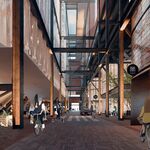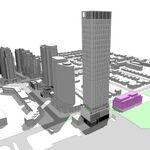nfitz
Superstar
And a lot don't - some not even at peak.Lots of trams in Europe run 5-6 minute frequencies.
And a lot don't - some not even at peak.Lots of trams in Europe run 5-6 minute frequencies.
Well, sure, but what's the argument here? Shouldn't we try to aim for the best frequencies possible?And a lot don't - some not even at peak.
View attachment 441467And this is mid December!View attachment 441465This is Bayview and Eglinton now.
Looks like a rather strange traffic configuration to-be. kind of reminds me of the Jarvis configurations which are hellishView attachment 441467And this is mid December!View attachment 441465This is Bayview and Eglinton now.
I don't think that we should be looking at what other cities do, as it has no bearing on what the actual ridership of the corridor is today or in the past.Well, sure, but what's the argument here? Shouldn't we try to aim for the best frequencies possible?
Personally, I have no idea how larger than 8 minute frequencies will attract people to use the service.
On the topic of Yonge/Eglinton LRT station - looks like the secondary entrance at the old Sally Anne site seems to be derelict. Is the plan to just get the main entrance done first and open the secondary entrance after the line opens?
good to know.. .thanks.I don't think that we should be looking at what other cities do, as it has no bearing on what the actual ridership of the corridor is today or in the past.
And when you consider at shortly before construction that there was something like 40 buses/hour every morning rush hour east of Yonge and 33 buses/hour west of the Allen, that should go a long way towards figuring out what the required headways will be. Especially once you factor in the rated capacity of each vehicle - that means that the rated capacity of the service is about 2000/passengers/direction/hour to the east and 1700/passengers/direction/hour to the west.
Working backwards from those figures - and assuming that the Crosstown LRVs are going to have roughly similar capacities to the Flexities downtown (130 people per vehicle), that means that the TTC should be looking at running the trains at a little less than 8 minute headways.
The old Salvation Army site isn't going to be an entrance/exit, but rather just for ventilation and emergency access - that's the concrete stacks at the back of the site.
The steelwork going up - and I can assure you it's not derelict, it's only been up for a couple of months - is for the new Salvation Army facility that is being built there.
Dan
8 Minutes would be ridiculous, at least pre-pandemic. You don't just have to worry about the 40 Eglinton buses, but all the new induced demand and new surface route connections. For instance, I would very much expect some people to start taking the Lawrence east bus now that they have a much easier connection to the subway network. Given we're still dealing with a pandemic shortfall, 5 minutes seems reasonable enough for now, but that will definitely have to increase as ridership improves.I don't think that we should be looking at what other cities do, as it has no bearing on what the actual ridership of the corridor is today or in the past.
And when you consider at shortly before construction that there was something like 40 buses/hour every morning rush hour east of Yonge and 33 buses/hour west of the Allen, that should go a long way towards figuring out what the required headways will be. Especially once you factor in the rated capacity of each vehicle - that means that the rated capacity of the service is about 2000/passengers/direction/hour to the east and 1700/passengers/direction/hour to the west.
Working backwards from those figures - and assuming that the Crosstown LRVs are going to have roughly similar capacities to the Flexities downtown (130 people per vehicle), that means that the TTC should be looking at running the trains at a little less than 8 minute headways.
Those 10-minute frequencies are on the outskirts of a system, or mixed sections (~2 lines), but certainly not the central section. You go to any Stadtbahn system (Koln, Dusseldorf, Hannover for instance), and the frequencies within the tunnel are usually around every 2 minutes, especially at the peak hour.If one looks at ridership and other systems in Europe, you see a need for 5-15 minutes service with 10 being the norm. Even in the US its 5-15 with 15 being the norm on a lot of systems with a few being only every 15.
I am expecting to see Hurontario starting off at 10 with one car then having a second car added. Wouldn't be surprised to 15 on the weekend and late at night time 7 days a week.
Even the S Bahn see 10 minute service at best.
Should we start a pool on the new new new launch date?8 Minutes would be ridiculous, at least pre-pandemic. You don't just have to worry about the 40 Eglinton buses, but all the new induced demand and new surface route connections. For instance, I would very much expect some people to start taking the Lawrence east bus now that they have a much easier connection to the subway network. Given we're still dealing with a pandemic shortfall, 5 minutes seems reasonable enough for now, but that will definitely have to increase as ridership improves.
Those 10-minute frequencies are on the outskirts of a system, or mixed sections (~2 lines), but certainly not the central section. You go to any Stadtbahn system (Koln, Dusseldorf, Hannover for instance), and the frequencies within the tunnel are usually around every 2 minutes, especially at the peak hour.
That would be my best guess as wellSept 2023
June 2023
optimistic!November 3033




